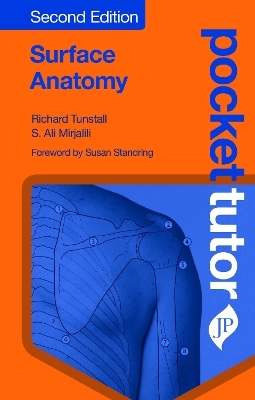
Pocket Tutor Surface Anatomy
JP Medical Ltd (Verlag)
978-1-909836-82-2 (ISBN)
The highly-structured, bite-size content helps novices combat the fear factor associated with day-to-day clinical training, and provides a handy reference that students and junior doctors can carry with them at all times.
Pocket Tutor Surface Anatomy is an indispensable guide to a subject that is increasingly important on today’s medical courses and a crucial preamble to the study of clinical skills and procedures, indeed to the study of all medicine and surgery.
Key Features:
Logical, sequential content: introduction to the principles of living anatomy, then chapters devoted to individual regions, with each sub-region illustrated by specially commissioned photographs featuring ghosted underlying structures
Each region (e.g. Upper Limb) described in a consistent manner: Introduction & Core Features which focuses on Arteries & Veins, Nerves & Dermatomes and Core Landmarks; then for each subregion (e.g. Shoulder & Arm) Bones Joints & Ligaments, Muscles Tendons & Regions, and Neurovascular & Lymph
Changes to second edition:
New chapter on paediatric surface anatomy highlights the anatomical differences in children and how they vary during development
15+ new and improved radiological images match surface markings to underlying structures
More sites of nerve injury, surgical incision lines and normal/pathological variation added to surface anatomy photos correlate anatomical landmarks to clinical practice
Chapters reordered from head to toe to provide a more logical and accessible ordering of content
Previous edition (9781907816178) published 2012.
Richard Tunstall BMedSci (Hons) PhD FHEA Head of Clinical Anatomy and Imaging, MBChB Admissions Lead, Warwick Medical School, Director of Clinical Anatomy, West Midlands Surgical Training Centre, UHCW Hospital, Coventry, UK Ali Mirjalili MD PhD PGDipSurgAnat PGCertCPU PGDipSci Senior Lecturer, Anatomy and Medical Imaging Department, University of Auckland, Auckland, New Zealand
Chapter 1 Introduction
1.1 The anatomical position and planes
1.2 Anatomical movements:
1.3 Sensory innervation
Chapter 2 Head and neck
2.1 Bones and bony landmarks
2.2 Intracranial structures
2.3 Muscles of the head and face
2.4 Nose, nasal cavity and paranasal sinuses
2.5 Nerves
2.6 Viscera
2.7 Oral cavity and oral vestibule
2.8 Neck
2.9 Neurovasculature
2.10 Viscera
2.11 Lymphatics
Chapter 3 Thorax
3.1 Bony landmarks, joints and cartilages
3.2 Muscles
3.3 Lines and folds
3.4 Mediastinum
3.5 Neurovasculature and lymphatics
3.6 Viscera
Chapter 4 Upper limb
4.1 Pectoral girdle, shoulder and arm
4.2 Elbow, cubital fossa and forearm
4.3 Wrist and hand
Chapter 5 The vertebral column and back
5.1 Vertebral column
5.2 Muscles
Chapter 6 Abdomen
6.1 Bony landmarks, joints and ligaments
6.2 Reference planes and regions
6.3 Muscles, tendons and aponeuroses
6.4 Inguinal canal
6.5 Neurovasculature and lymphatics
6.6 Surgical incisions of the abdominal wall
6.7 Viscera
Chapter 7 Pelvis and perineum
7.1 Bones, joints and ligaments
7.2 Perineum
7.3 Female
7.4 Male
7.5 Perineal neurovasculature
Chapter 8 Lower limb
8.1 Pelvic girdle, gluteal region and thigh
8.2 Knee, popliteal fossa and leg
8.3 Ankle and foot
Chapter 9 Surface anatomy in children
9.1 Growth and proportions
9.2 Thorax
9.3 Respiratory system
9.4 Cardiovascular system
9.5 Abdominal wall and GI tract
9.6 Genitourinary system
9.7 Musculoskeletal system
9.8 Nervous system
9.9 Skin and subcutaneous tissue
| Erscheinungsdatum | 10.05.2021 |
|---|---|
| Reihe/Serie | Pocket Tutor |
| Zusatzinfo | 260 Halftones, color |
| Verlagsort | London |
| Sprache | englisch |
| Maße | 113 x 177 mm |
| Themenwelt | Studium ► 1. Studienabschnitt (Vorklinik) ► Anatomie / Neuroanatomie |
| ISBN-10 | 1-909836-82-6 / 1909836826 |
| ISBN-13 | 978-1-909836-82-2 / 9781909836822 |
| Zustand | Neuware |
| Haben Sie eine Frage zum Produkt? |
aus dem Bereich


